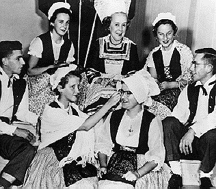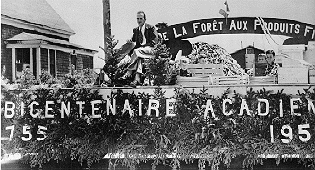
 Acadian
Identity: crisis or awakening?
Acadian
Identity: crisis or awakening?

It is under Father Patrice-Alexandre Chiassonís mandate that Acadians
in the area became more assertive. As the first Acadian Superior, Chiasson
wished to improve the social, academic and religious life of Acadians at
Sainte-Anne.
The Acadians in Southwestern Nova Scotia were slowly taking hold
of certain issues concerning their identity. Many congresses and celebrations
which were held at Sainte-Anne presented occasions for the Acadians in
the community and at Sainte-Anne to express themselves. This awakening
of national enthousiasm took place in the years following 1930 because
prior to this, the presence of French Eudist Fathers dominated life at
Sainte-Anne and in many parts of the region as well. Because of the Eudist
Fathers' desire to have things as "French" as possible at the institution,
Acadian identity was not promoted. For example, there were no Acadian history
courses offered in the curriculum.

The twenty years between 1940 and 1960 were significant for
the Acadians of the area. One of the Superiors at this time was Father LaPlante
and he was very devoted to the Acadian cause. During his term,
líAssociation acadienne díéducation de la Nouvelle-Écosse
was created in 1950, and a year earlier, La Chambre de Commerce
de Clare had been established. 1955 marked the bicentennial of the
Acadian expulsion from Nova Scotia and many festivities were held in and
around the College. One such activity was the Festival acadien de Clare
which is still celebrated today.
July 6, 1953, was an important date for the Acadians of Southwestern
Nova Scotia because it marked the creation of the Diocese of Yarmouth. The
setting up of this religious structure had been a long and painful task
and it was mainly through the efforts of Father LaPlante and Monseignor
Ildebrando Antoniutti that the project was brought about. The new
Diocese comprised the counties of Shelburne, Yarmouth, Digby, Annapolis,
and Kings. Many reasons account for the motivation behind the project,
however the desire to counteract assimilation and to ensure religious devotion
in French seems to have predominated.